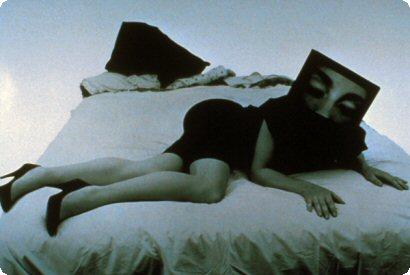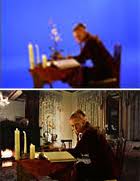Serendip is an independent site partnering with faculty at multiple colleges and universities around the world. Happy exploring!
Week Six (Wed, 2/23): Digital thinking and re-thinking

Lynn Hershman, Seduction (Phantom Limb Series), 1988
I. (Liz) Coursekeeping
signing in
taking notes: J.Yoo and PhreNic
Besides your usual weekly post this Friday, responding to this week's conversation, you also need to post, this Friday, who you will "be" next week. There's a "sticky post" @ the top of our course forum; please just "add a comment" to that w/ a short description of your "character," so that we can plan the panels--> i.e., who goes Monday, who Wednesday. We'll put up the groups on Sunday; but just plan to go on Monday so you won't be unpleasantly surprised!
did everyone get a writing conference scheduled?
(those who were missing Monday: jlebouvier, Marina, Merlin, spreston?)
does everyone else remember when they're scheduled to come?
please admire, appreciate (and use!) the newly
click-able syllabus w/ re-labeled course notes
(in response to popular demand)
II. reviewing the pattern our minds made
III. (Anne) looking back @ (how Hayles says) we think
Digital Humanities a "massive theoretical shift in textual studies," in which print is absorbed into new hybrid, multimodal communication practices; time-based forms (film, sound, animation), visual traditions (graphics, design), spatial practices (architecture, geography), curatorial practices (museums, galleries), etc.
a paradigm shift: core mission springs from practices, qualities in any medium, reaching beyond print in modes of inquiry, research, publication, dissemination
single most important issue is matter of scale:
changes the amount of text, contexts, contents of questions;
distance becomes a condition of knowledge,
allows focus on units smaller (devices, themes, tropes)
or larger (genres, systems) than the text
algorithms "read" because they avoid
the principal trap of conventional reading:
assumptions filtering the material,
so that we only see what we expect to
(i.e. human interpretation misleads);
this allows new convergences to become visible
posthuman mode of scholarship part of long
history of human adapting to new technologies
(cf. Andy Clark!)
"the cartographic imagination": meaning built not linearly but in
connections of layered networks, moving from temporal causality to
spatialized grids: multi-focal, multi-causal, non-narrative modes of representation;
increasing reliance on visualization tools
"Forget meaning. Follow the data streams."
effect of database format: liberate contradictory, refractory threads in material from coherence of historically-based arguments; visual topics as potatoes in field, navigated by 'digging'; generate content that allows others to provide own representation; shift emphasis from argumentation to data embedded in different forms, orderings, manipulatable by the user
Humanists' tout critique rather than contribution (not producing new knowledge but questioning modes of production); time to critique the mantra of critique
two major strategies: assimilation (extend existing scholarship into digital realm) and distinction (new methodologies)
IV. So, let's try this out! viewing Conceiving Ada through this lens
 |
 |
count to 9 re-organize yourself into groups of 3
assure yourself of one another's names
re-conceive Conceiving Ada as a digital humanities project:
1. What was your response to the film?
2. What questions does the film raise for you?
3. How can you place it within the frame of this course?
How does it illustrate-or-challenge some of the ideas we have been exploring?
4. How would you teach it, using the tools that Hayles describes?
In her terms, what would a "posthuman" mode of
scholarship look like, when applied to this visual object?
* How would you use the film (for example) to
demonstrate "the cartographic imagination"?
* What would it mean, in discussing this film,
to "forget meaning" and "follow the data streams"?
* How could you use it to avoid "replicating existing
paradigms," to "critique the mantra of critique"?
IV. Reporting back: let's teach one another this film
V. Reading/Reporting Out Notes from
The Art and Films of Lynn Hershman Leeson: Secret Agents, Private I (2005)
Ada is gender-information-science-technology in biographical form;
she predicted the possibilities of artificial life and the
digital revolution that arrived 144 years after her death
35 mm. film made in 1997; first feature film to use virtual sets
LHL invented a process for digital sets for Conceiving Ada, that
allowed still images to be dynamically placed into live digital video,
becoming the backgrounds that actors moved through, recorded in real time
took 375 images @ bed-and-breakfast hotels in San Francisco;
digitized and called them up when needed;
actors placed themselves by looking @ the filmed environment in a monitor
scenes (fire, rain, doors, etc.) animated in Quicktime movies

virtual sets an interactive element: spontaneous, interactive process of
shooting live action while simultaneously manipulating digitalized backgrounds
motivated by small budget, short shooting schedule (Tilda had 6 days);
couldn't afford to build sets
appropriate to tell Ada's story using techniques she helped to invent
LHL's work important for her pioneering use of new technologies
and for its investigations of key social issues:
identity in a time of consumerism,
privacy in an era of surveillance,
interfacing of humans and machines,
the relationship between real and virtual worlds
b. Cleveland 1941
bachelor'sin Education, Museum Administration and Fine Arts
Master of Fine Arts: thesis = writing art criticism under 3
pseudonyms: Prudence Juris, Herbert Goode and Gay Abandon
exhibit of wax figures--w/audiotape of breathing
and voices--canceled by UArt Museum, Berkeley
one of first installations outside a gallery setting, The Dante Hotel:
each artist rented and furnished a hotel room; multiple strata of
life contained by a place or site in a given socioeconomic environment
"Self-Portrait as Another Person"
1973 to 1978, adopted persona of Roberta Breitmore
30 videos
telerobotic pieces and experiments with works
that use both in situ and Internet elements
LORNA was an early project of Leeson. The first interactive laser artdisk, LORNA tells the story of an agorophobic woman. Viewers have the option of directing her life into several possible plots and endings. LORNA never left her one room apartment. According to Leeson, the objects in her room were very much like those in The Dante Hotel. Except that there was a television set. As LORNA watched the news and ads, she became fearful, afraid to leave her tiny room. Viewers were invited to liberate LORNA from her web of fears by accessing buttons on their remote control unit that corresponded to numbers placed on the items in her room. Instead of being passive, the action was literally in their own hands. Every object in LORNA'S room contains a number and becomes a chapter in her life that opens into branching sequences.
The viewer/participant accesses information about LORNA'S past, future and personal conflicts via these objects. Many images on the screen are of the remote control device LORNA uses to change television channels. Because viewer/participants also use a nearly identical unit to direct the disc action, a metaphoric link or point of identification is established and surrogate decisions are made for LORNA. The telephone was LORNA'S link to the outside world. imageViewer/participants chose to voyeuristically overhear conversations of different contexts as they trespassed the cyberspace of her hard pressed life. There were three endings: Lorna shoots her television set, commits suicide, or moves to Los Angeles.
Course notes: J.Yoo and PhreNic


